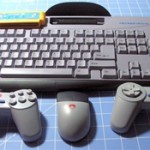 Maker Shed has started stocking these 8bit TV-Computers (you may remember from our post here). For $50, you get:
Maker Shed has started stocking these 8bit TV-Computers (you may remember from our post here). For $50, you get:
- Contains a 1Mhz 6502 chip–the same technology that ushered in the “Home Computer Revolution” in the 1980s.
- Each box comes with a keyboard, mouse, 2 game controllers, operating system cartridge, RCA cables (NTSC video and stereo audio), and a 9 volt power supply.
- Plays 8-bit 60-pin Japanese game cartridges (such as Famicom cartridges, or NES cartridges with an NES to FC converter)
- Supplied Cartridge comes with:
- Mandarin Chinese 8-bit GUI with English DOS prompt
- BASIC programming language and sprite manipulator (in English)
- 8-bit Music composer
- “Visual Theremin” Mode
The last two are highlighted because I ahve never heard of them. Anyone know what they are like? And hopefully Maker Shed will start carrying eeprom carts for this sucker soon..
